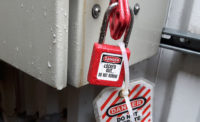A recent survey found 68 percent of respondents reported experiencing electrical near-misses at their facilities in the past five years.
An unplanned event that did not result in injury, illness, or damage, but had the potential to do so — are common but generally underreported. Knowledge is power, and information provided by near-misses is a tool to evaluate and improve safety.
Reporting is just the first step. Without cultural change, the process will break down. Committing resources to investigate near-miss causes and institute improvements will result in fewer injuries and disruptions.
Safety attitudes & actions
Cultivating a safety culture where near-misses are reported and recorded requires a shift in thinking that starts at the top. Leadership must look at near-misses as genuine opportunities to improve, rather than disappointing shortcomings.
This tells workers leadership is taking a proactive role in improving safety. Knowing where the hazards are is the first step to mitigating them, and a near-miss provides valuable information without the high costs of damage or injury.
To have an effective near-miss reporting program, the stigma of blame needs to be eliminated. Employees are often reluctant or afraid to report near-misses because they don’t want to admit they made a mistake or they believe they will face disciplinary action.
Employees need to be as comfortable reporting near-misses as they would reporting a hallway needs to be cleaned or a hazard sign needs to be replaced. This can’t happen if reporting near-misses results in blame or negative consequences.
Identifying hazards, identifying improvements
Reporting near-misses provides a baseline for improvement, but safety managers need to address “non-events” to identify and eliminate hidden hazards. What was the root cause? What corrective actions can be taken to prevent a repeat with serious injuries and disruptions?
Frequent near-misses indicate a need for improving risk reduction. Once the root cause and underlying hazards are identified from a near-miss, corrective action needs to be implemented. The hierarchy of controls is one tool to identify and rank possible solutions. The hierarchy ranks control measures according to their effectiveness in removing or controlling hazards. This systematic approach needs to be fully understood before it can be used effectively. Risk control measures in the hierarchy ranked from most to least effective include:
- Elimination physically removes the threat -- often difficult or infeasible, when dealing with electrical hazards.
- Substitution replaces the hazard with something non-hazardous. Minimizing the hazard or provide simplification should be considered here.
- Engineering controls prevent access or act as a barrier between personnel and hazards. As built-in systems, they are less susceptible to human error. Controls can be passive or active.
- Administrative controls attempt to change the way people work through training, procedure, policy, and signage.
- Personal protective equipment is often required in tandem with administrative controls. It’s imperative PPE is inspected before each use and used appropriately because hazards are still present.
Evaluate where your existing safety technology falls on the hierarchy of controls compared to current best practices. This may provide leverage to upgrade outdated safety equipment and procedures.
Automating engineering controls
Electrical workplace injuries have remained relatively unchanged in the past decade1. This indicates that it is extremely difficult to bring the number of incidents to zero relying solely on administrative controls and PPE. Prevention through design—reducing exposure to hazards through design practices—is key to mitigating risk. This is true especially for electrical hazards, where new technology and innovations are making great strides in increasing safety.
Engineering controls are more effective and reliable than administrative controls and PPE alone when it comes to protecting workers from electrical hazards. They are often more feasible than substitution or elimination. Industry is increasingly focusing on automation and prevention through design to minimize human error risk.
When it comes to exposure to electrical hazards, voltage testing and absence of voltage verification is at the root of many near-misses. Proper adherence to voltage testing procedures with a handheld tester has undoubtedly prevented scores of injuries, but its dependence on human input makes it vulnerable to mistakes and errors. Plus, the process itself requires direct worker exposure to hazards.
Substituting a manual process that relies primarily on administrative controls like PPE and training, with an automated process that leverages engineering controls designed into a system, can provide an enhanced level of safety, increase the reliability of the process, and decrease the risk of exposure to electrical hazards. This is critically important, especially for a process like voltage testing and absence of voltage verification performed multiple times per day.
Examples of engineering controls for voltage testing and absence of voltage verification include innovations such as permanently-mounted voltage indicators, voltage test portals, and absence of voltage testers, that allow the presence or absence of voltage within an electrical enclosure to be determined without opening doors or removing covers.
On-target to eliminate hazards
Using near-misses as a tool to uncover and eliminate potential hazards reduces the risk of damage and injury. Implementing a process of reporting and investigating can be a challenge upfront, but once established the information provided can be invaluable.
It’s important to continually identify and assess potential hazards. As advances in technology occur and new products are released, new ways to mitigate old hazards become viable. Control measures that are designed-in are more effective and provide greater business value than other administrative approaches such as training or PPE alone. Obtaining the buy-in to implement practices and technology that sits higher on the hierarchy of controls can be a challenge, but tracking and investigating near-misses can prove that the up-front capital costs required are well worth the productivity savings and avoiding the costs associated with incidents.



